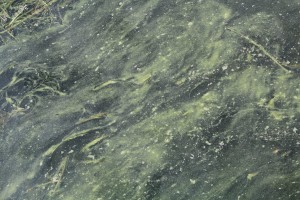PUT-IN-BAY, Ohio — The harmful algal bloom forecast released July 10 by the National Oceanic and Atmospheric Administration remains unchanged, according to a scientist with the National Oceanic and Atmospheric Administration.
Rick Stumpf told reporters at a Lake Erie science writers event, Aug. 18, that the forecast of a “significant” bloom is still on track, and that the bloom is still rated a “6” for severity, with 10 being the most severe — as seen in the record bloom of 2011.
“We’re still in this range in the neighborhood of about 6 in severity,” he said. “We still expect, unfortunately, that the bloom has not peaked. We expect it to peak in September.”
In comparison

The harmful algae — also known as cyanobacteria — typically bloom in late July. So far, there is less than half of the biomass of the 2011 bloom, Stumpf said.
When harmful algae bloom, the impact can be quite localized, he said, depending on the wind and how well an area is prepared to handle the bloom.
“It (the bloom) might remain pretty much concentrated in one part of the Western Basin, or it could spread out,” he said. “There’s no way for us to predict it — at this time —that far out.”
During bloom season, NOAA publishes news bulletins twice weekly to email subscribers, which show the size of the bloom and where it’s moving. In addition, the Ohio EPA provides a harmful algal bloom advisory map, under “Harmful Algal Blooms.”
Ohio currently follows the World Health Organization safe drinking level of 1 part per billion of the toxin microcystin. Infected water is safe to swim in up to 20 parts per billion. The lake’s highest level was 60 parts per billion until 2011 — when records were shattered at 1,200 parts per billion.
Toledo scare
Jeff Reutter, who directs Ohio State University’s Stone Lab on Lake Erie, said municipalities can combat the effect of algae in the water by adding carbon, often through agitated charcoal. The toxins, including microcystin, bind to the charcoal particles and are filtered out of the water.
In the recent Toledo water ban, Reutter said the amount of toxin going into the water exceeded the amount of carbon being used. The goal, he said, is to match the carbon put into the plant with the amount of toxin, which brings the toxin level down to acceptable levels.
“What happened in Toledo is that the concentration of the toxin going in exceeded the amount of carbon that they had going into the plant to remove that toxin,” he said.
Reutter said Toledo was able to correct its problem by adding more carbon. He said water treatment plants do not want to overuse carbon, because it is costly.
The Toledo water ban lasted two days and impacted at least 400,000 people.
While serious, Reutter said it’s important to keep the issue in perspective, and to remember that the weather can change things quickly.
“The vast majority of the lake is not impacted at this point,” he said. “You want to keep people informed on where they should be concerned, but also follow (the reports) closely.”









